Menu

Since October 1976, Congress has used the “small farm exemption” to protect farms with 10 or fewer workers from OSHA rules. This shows how changes from the Environmental Protection Agency (EPA) are not just small tweaks. They’re making big changes to farm rules.
EPA’s rules are focusing more on being green. This means thinking about the environment a lot. They look at how farm work affects the air and water, energy use, and pesticides. Their goal is to keep farming strong economically but also safe for the planet.
The farming world is worried but understands the need for these new rules. They see the impact of their work on nature. They also get that keeping the environment healthy is vital for their future. Both the EPA and the Department of Agriculture (USDA) are working to protect nature while keeping farms running.
Farmers need to follow agriculture machinery regulations for a green and profitable industry. Before, states controlled the farming’s impact on nature. But now, rules aim to protect our planet without harming farm work.
Having set rules for farm gear shields our world and keeps farming profitable. The Health and Safety Act from 1974 cares for farm safety. Today, machinery must be CE marked to fit safety standards. Plus, brakes and other parts must be checked often to keep farm machines safe.
Dressing right, tying up long hair, and wearing a seatbelt can cut down on accidents. Flying bits from mowers and getting caught in balers are big risks. The laws of 1992 make sure machines are safe from the start, made well by their makers.
Agriculture used to dodge tight federal laws, with states doing most of the control. But, old machines now need to meet today’s standards. As time goes by, following these rules is becoming more of a must, not an option.
Rules have changed along with the kind of machinery, like combine harvesters. They can snag, hit power lines, and cause dust issues. With new laws and a lot on safety, farming is getting safer and greener.
Environmental laws are changing, affecting how farmers use equipment. These changes show a bigger worry in farming. Agencies like the EPA and USDA are making sure farmers use new equipment and methods. They aim to improve how farming affects the environment.
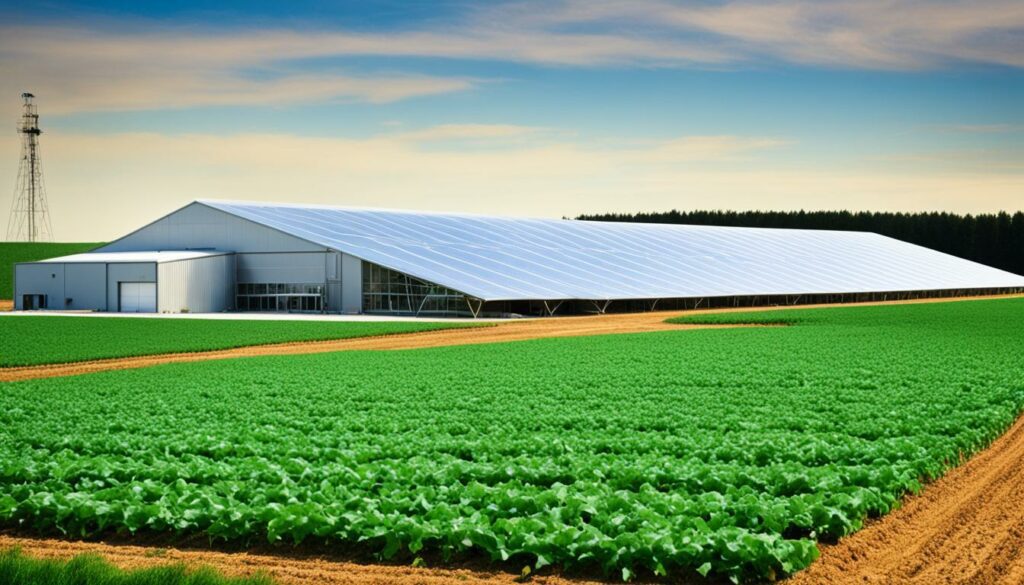
The EPA set new safety rules that have got people talking. They focus on reporting greenhouse gas smoke and setting standards for air quality. They also look at how much pollution comes from big engines. These rules are to make the air cleaner. Yet, many farmers say they cost too much and are hard to follow.
Because of these rules, machinery is getting more high-tech. It all must meet the new environmental standards. For example, new engines make less dirty air. This meets the government’s tough pollution rules.
Also, rules are now in place to keep our water clean. Big farms must now have a special permit to operate in a way that doesn’t pollute. This keeps harmful things out of our water. It also means equipment has to work in ways that don’t harm nature. Laws like the Renewable Fuels Standard push for better, greener machinery. This includes machines that run on eco-friendly fuel like E15.
Farm equipment is changing a lot to keep up with new laws. The aim is for farming to be kinder to the planet. While this brings up some challenges, it also opens doors for better farm practices.
The focus is on making farming better for our environment. This includes making sure farms help, not harm, big environmental goals.
Citation: “The enforcement of strict air and water quality standards ensures that agricultural practices do not compromise public health and environmental integrity.” – EPA
| Regulatory Focus | Primary Impact | Agency Involved |
|---|---|---|
| Greenhouse Gas Emission Reporting | Comprehensive emission tracking | EPA |
| NAAQS for Particulate Matter | Air quality improvement | EPA |
| CAFOs Permitting Requirements | Water quality protection | EPA |
| Renewable Fuels Standard (E15) | Biofuel utilisation | USDA |
Many governments work together to make sure farms stick to environmental rules. The EPA and USDA play big parts in making laws for farm machinery. In this piece, we look at why these rules are important for keeping farms eco-friendly.
The EPA works to protect the environment and sets rules for things like pollution and pesticide use. The USDA helps farmers by teaching them, giving advice, and financial help to go green. Local and state governments also help by tailoring and enforcing these rules to fit their own areas.
Farmers need to know and follow many rules about their machines to stay legal. Since 1976, all working tractors must have Tractor Rollover Protection. Farmers also must keep everyone safe from pesticides and give young workers special safety training.
States often have their own rules, especially about keeping water clean and ensuring safe working conditions. Even though some small farms might not have to follow every rule, sticking to laws is key for safe farming. Meeting these standards is good for both the environment and the health of those working on farms.
| Regulation | Agency | Key Provision | Impact |
|---|---|---|---|
| Tractor Rollover Protection (ROPS) | OSHA | Mandatory ROPS on tractors | Enhances worker safety |
| Worker Protection Standard (WPS) | EPA | Reduce pesticide risks | Improves health standards |
| Hazardous Occupations Order in Agriculture (HOOA) | USDA | Youth training for hazardous tasks | Ensures youth safety |
Many levels of government work together to make a full set of rules for farm machines. By following these, farmers can run their farms well and keep the environment safe.
Air quality rules are key in lessening the damage from farm machines. They guide how to cut down on harmful gas in farming and boost the air we breathe. These steps help make our air cleaner through better farming ways.
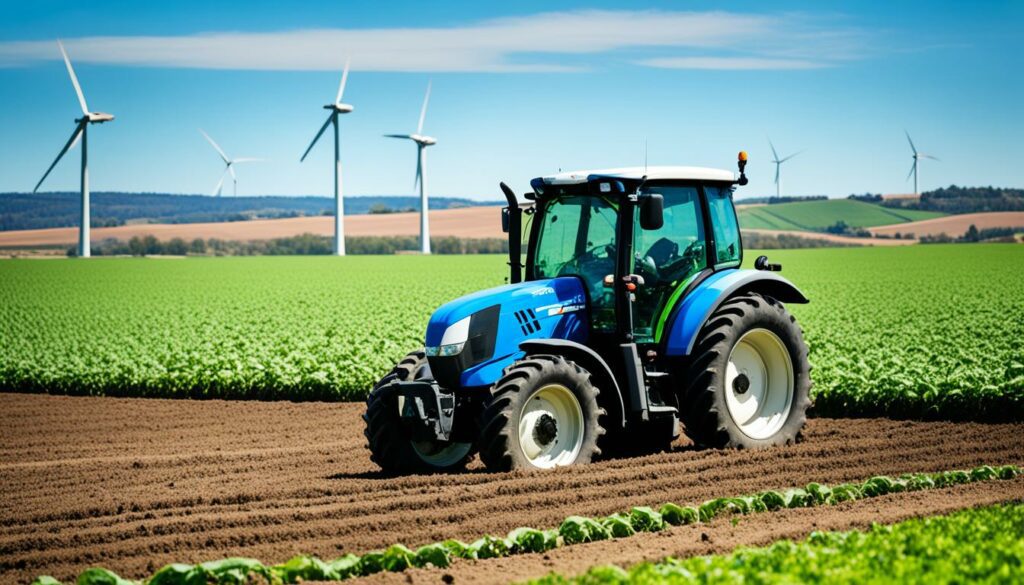
The Clean Air Act says we must track Greenhouse Gases (GHGs) in areas like farming. It makes sure we watch over and control the gas we produce. This rule is important even though it can be hard and costly, as it helps lower our bad gas output from farming.
The law also tells us how much dust from farming is okay in the air. Some think these dust rules hurt how much food we make, but they’re needed to make the air better.
Diesel engines in farming make a lot of dirty air like CO2 and NOx. To fight this, we’re using new tech and stricter rules to clean the air from farm machines.
Places like the EU and the US make laws on how much bad air farm machines can make. This pushes companies to use cleaner engines and filters so our air is less polluted.
Farmers need to meet these clean air rules to use their machines. By picking equipment that follows these rules, they help keep the environment safe while still farming well.
Water quality standards are now key for farms, thanks to the Clean Water Act. This Act puts rules on farms and requires them to tackle water pollution from their activities. Farm equipment must now focus on keeping water clean and meeting set standards to farm in a sustainable way.
The Clean Water Act demands farms get permits for any water they release, affecting how they operate. To avoid fines and protect the environment, farmers need to stick to these rules. They must carefully manage the water they use, checking its quality and treating it. Tasks like checking water quality, following treatment plans, and keeping records are crucial for meeting environmental standards.
Technology in agriculture is moving fast to help with water use. Farmers can now meet tough water quality rules easier thanks to new tools. For example, there are smart ways to water crops, methods that use water more precisely, and advanced water cleaning systems. These innovations cut down on water waste and pollution. They help farmers follow the law and be more efficient.
The study from China looked at data from 34 places over several years. It measured the growth of farming in a way that included caring for the environment. The research showed that farms can adapt to strict water rules better when they manage land well. Good land management is key to dealing with tough water laws.
Experts suggest making better rules and support systems to handle the water challenge in farming. They said if these improvements happen, farmers can follow the strict water rules easily. And, they can still grow their crops in ways that are good for the land and people.
Energy efficiency is key in farming. We want to farm in ways that protect the environment. This means equipment must use less energy. Manufacturers are working on new features to save energy. This is needed to meet energy rules.
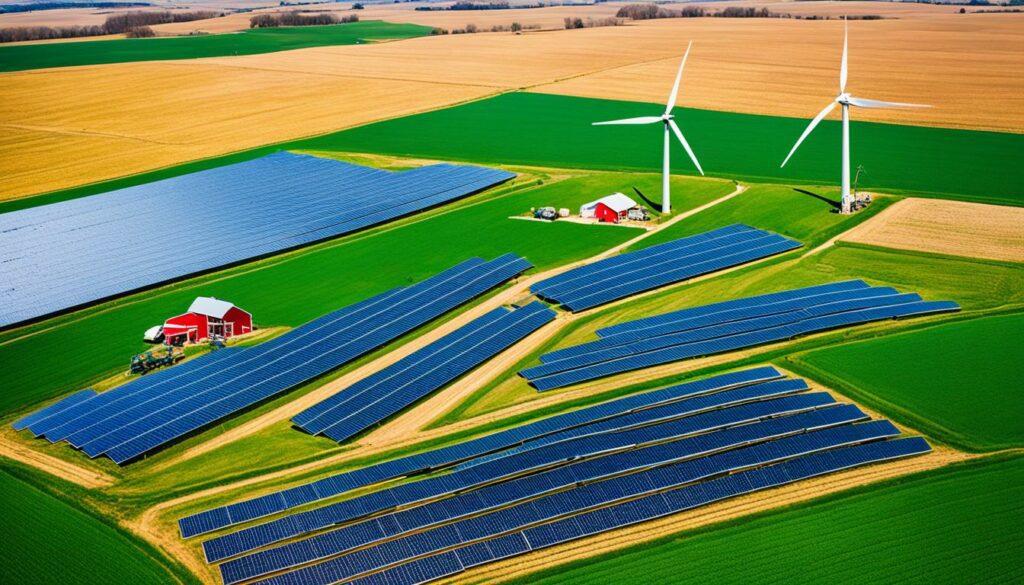
The Renewable Fuels Standard (RFS) Rule is changing farming for the better. It pushes for renewable energy like biodiesel. These new sources cut our need for oil and meet clean energy rules. It helps make farms more sustainable and lowers harmful gas.
New farm tools are being made to be energy efficient. They have smart systems and green engines. These changes are making a big difference. The use of GPS on farms has already saved lots of fuel in the U.S.
Using less energy while farming is a big goal. Farming in ways that need less fuel is getting more common. Rules are pushing for machines that use energy better.
Machines must be smart about using energy today. Doing small things like filling tyres right and looking after the machines can save a lot of fuel. This saves money and is good for the planet.
Rules about pesticide use have changed how farming is done. They cover more than just how pesticides are sprayed. The rules make sure farming is safe for people and nature. Environmental rules on pesticides keep us all safe by making sure chemicals are used carefully.
Some situations don’t need all the rules, like using bait or algaecides in water. This recognizes different risks and helps keep safety equipment in check. Also, groups focused on pest or disease control might follow fewer rules. This shows that pesticide laws can be flexible too.
It’s important to tell farm workers about the dangers of pesticides. Employers must give them information in English and Spanish. They also need to keep records of pesticide use and safety information for two years. This helps ensure everyone stays healthy.
Before work starts in treated fields, farm workers must know what’s in the chemicals used. Records must be available within 48 hours if anyone asks. This helps protect workers from getting sick or hurt by pesticides.
Looking at how well farms follow these rules can help make them better. Knowing if there are too many rule breaks helps see if we’re on the right track. Watching how pesticides are used in water and making sure those workers stay safe is also key.
Using closed systems for mixing pesticides is another safety step. It reduces the risk of getting too close to the chemicals. Knowing what jobs are most at risk can help train workers to be safer. This leads to better rules that help farming stay safe for everyone.
Making sure we follow environmental safety rules is key in farming today. The OSHA, or Occupational Safety and Health Administration, is key in this. They set and make sure farms follow safety rules, aiming for a safe workplace no matter the farm’s size.
OSHA focuses on setting up big safety steps in farming. They cover how to use farm tools right, check for dangers, and stop accidents. Rules are strict about tractor safety as these are used a lot on farms. Making sure machines have guards shows how important safety is for workers. OSHA’s safety rules are careful to fit all different farm types.
OSHA also makes farms take care of their workers’ health and safety. They guide on lessening bad chemical exposure, correct training, and keeping gear safe. They want farmers to protect workers’ health both now and in the future. Giving out safety clothes, comfortable work set-ups, and regular health checks are key under OSHA’s rules.
States and local areas add more rules to these federal ones, based on their farming needs and safety spots. As farm safety laws change, focusing on air and water safety is key. The big aim is always to keep farm workers safe while following all environmental and health rules.
| Regulatory Aspect | Guidelines | Compliance Requirements |
|---|---|---|
| Machinery Safety | Tractor safety, machinery guarding | Regular maintenance checks, risk assessments |
| Worker Health | Exposure to hazardous substances, training protocols | Provision of PPE, routine health checks |
| Environmental Compliance | Emission controls, water quality monitoring | Adherence to federal and local regulations |
The Right-to-Repair movement is very important today. It fights for the rights of farmers and against rules that stop them fixing their own machines. I’ve seen how some farming gear has special technology that only the makers can control. This makes it hard for farmers to fix things on their own. The movement aims to make laws that give farmers the Right-to-Repair their machines. This would mean farmers could do more themselves to keep their tools working.
To get what Right-to-Repair is about, think of the problems farmers have with high-tech farming gear. Special software and tight repair rules made by the makers hold them back. For example, John Deere has been in court many times over claims it stops others from fixing its machines. Most people in the US think makers should help buyers fix their machines. This is why Right-to-Repair has broad support.
By 2023, 33 states and Puerto Rico looked at laws supporting Right-to-Repair, with some putting laws in place. States like Colorado were the first to focus on farm machines. Nine others made similar laws just for farmers’ equipment. These new laws are a direct answer to how hard it is for farmers to deal with high-tech machines.
| State | Legislative Action |
|---|---|
| California | Passed right-to-repair legislation |
| Colorado | First to target agricultural equipment |
| Minnesota | Passed right-to-repair legislation |
| New York | Passed right-to-repair legislation |
This fight is growing, as shown by a big case against John Deere grouping 18 lawsuits together. Farmers say these rules stop them from fully owning their machines. They also struggle to get fair repair options. Many end up using old machines due to new tech’s complexity.
Fixing the Right-to-Repair issue is crucial for farmers’ property rights. Acts and talks in the farming industry need to focus on repair options. This should give farmers the power to fix their own equipment. It would create a fairer farming world for everyone.
Machinery certification is crucial for farm equipment. It ensures these tools meet high safety, environmental, and performance rules. Knowing about these rules helps keep farming gear safe and eco-friendly.

Agricultural machinery must meet strict standards. The EU’s EMC Directive is a must. So are rules like EN ISO 14982:2009 and EN ISO 13766-1:2018. They check gear in farming, logging, and construction.
Large machines and their parts must pass EMC tests. Elite offers detailed checks. Third-party bodies also do type-certification. They make sure gear follows rules on EMC. This includes limits on emissions and how well it resists interference.
These standards really change how equipment is made. With rules always updating, makers must keep up. Old standards like EN 13309:2010 are now new. This makes production and sales planning difficult.
World groups like the ISO also set rules. They’ve got more than 1,000 for farming tech. The ISO/TC 23 team adds rules on eco-friendliness. All this shows how wide-ranging the impacts of these rules are.
ISO makes new rules often. With 21,500+ to follow, makers have lots to keep track of. They must meet today’s and tomorrow’s standards. This is to stay competitive. Machinery certification is a big deal for safety, green goals, and quality. It shapes how makers work with rules.
Sustainable farming guidelines are changing how we farm for the better. These rules focus on using equipment that’s kind to the earth. They help farms run better and protect the environment. This way, farming can keep going strong without harm.
The focus is on making farm tools that are good for the planet. For instance, choosing drip irrigation saves water and boosts crops. Cover cropping stops soil from washing away and helps bees too. These steps show how farms can be a win for everyone: the economy, people, and nature.
Using the best farming methods means a mix of new and old ways. For example, not plowing the soil keeps it healthy and uses less fuel. Integrated pest management helps crops without hurting people or the environment. And when fighting weeds, going natural with plant rotations saves the day without toxins.
| Practice | Benefits |
|---|---|
| Smart Irrigation | 20-40% water savings, 20-50% increase in crop yields |
| Cover Cropping | Reduces soil erosion, builds organic matter, decreases fertiliser expenses |
| No-Till Farming | Prevents soil erosion, reduces compaction, lowers fossil fuel emissions |
| Integrated Pest Management | Minimises harm to humans, non-target species, and the environment |
| Sustainable Weed Control | Avoids chemicals, promotes crop rotation and cover cropping |
Following these guidelines and using eco-tools helps farmers protect the earth. It makes their land produce well for years to come. This not only helps farms but also our overall environment and communities. It builds a future where farming and nature thrive together.
The future of agriculture will be shaped by new technology and strict environmental checks. We expect machines to get more efficient and eco-friendly.
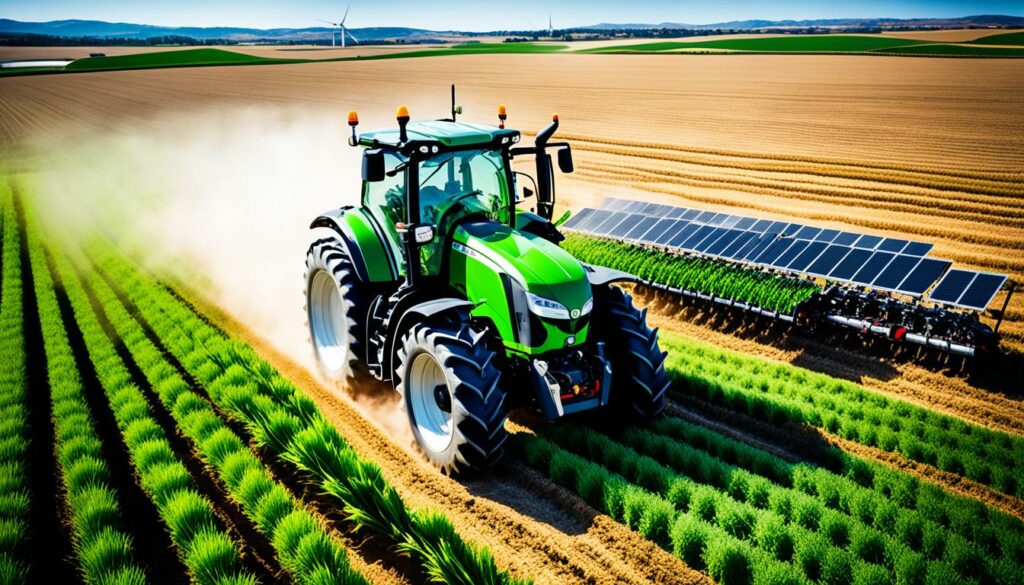
Technological growth in farm tools is changing how we farm. Companies like John Deere and Kubota are pushing forward with precision farming and robots. This helps manage crops better and makes decisions using data, leading to machinery working better.
After the pandemic, the global market for heavy machinery will pick up. Rentals will help smaller farms and Asia-Pacific will grow faster than North America. This will be because more people are using advanced farm equipment.
New equipment must meet strict environmental rules. Companies such as Monsanto and Agco are at the forefront. They’re using technology to make farming more efficient and reduce harm to the planet.
There’s a big push for farming machines to be better for the environment. They’re working on keeping the land healthy, using less water, and being more productive. This will help meet the demand for more food. Also, making equipment closer to where it’s used will make sure it’s always available, even when unexpected things happen.
| Factor | Impact |
|---|---|
| Technological Advancements | Increased Efficiency, Data-driven Decisions, Enhanced Productivity |
| Environmental Assessments | Reduced Inputs, Early Disease Detection, Water-Saving Techniques |
| Market Predictions | Growth Post-Pandemic, Regionalisation for Supply Chain Adaptability |
| Geographical Trends | Asia-Pacific Region Growth, Surpassing North America |
In conclusion, the future of farming equipment is tied to tech and being eco-friendly. By adopting these changes, farming will reach new heights of productivity and sustainability.
Implementing new farm equipment standards brings many implementation challenges to the agricultural sector. We are moving towards stricter environmental laws. But, we must balance innovation with being practical and cost-effective. One big hurdle is the high costs of new technologies. Even though precision agriculture has been around since the 1990s, by 2023, only a quarter of U.S. farms use it.
Then there’s the issue of farm equipment standardisation difficulties. This problem gets worse without common standards. It slows down the spread of useful technologies. While federal agencies have tried to help, problems with sharing data and who owns it continue.
Also, following new agricultural regulations is tough. It needs farm operators to not only buy new things but also to learn a lot. To help, federal agencies offer money, loans, and clear goals. But, making sure farmers understand and follow the rules is still hard. Dealing with these challenges means offering money and promoting better use of data and training.
New tech like remote sensors and weeders does offer good ways forward. They can help make more money and use fewer resources. However, getting these tools widely used faces issues with standardisation and keeping up with rules. Plus, the increase in electric vehicles for farming adds more challenges. This means we need better infrastructure, especially high-speed internet in rural areas, for these new tools to work well.
In the end, tackling adapting to agricultural regulations needs a lot of work. We must face today’s implementation challenges and support new ideas. By doing so, the agriculture sector can step into a brighter, more sustainable future.
Case studies in agriculture teach us a lot. They show how new farming techniques and following rules have worked well. These show how farms can change to meet tough environmental laws and keep working.
The Argonne National Laboratory is a great example. It worked on its green plan and saw big improvements. It used more computers with energy-saving settings and composted a lot more. This showed that following environmental rules can really help the planet.
The Sam Rayburn Memorial Veterans Center also did a lot. It collected rainwater, changed all light bulbs to LED, and taught its staff about being green. These actions made a big difference in making the environment better.
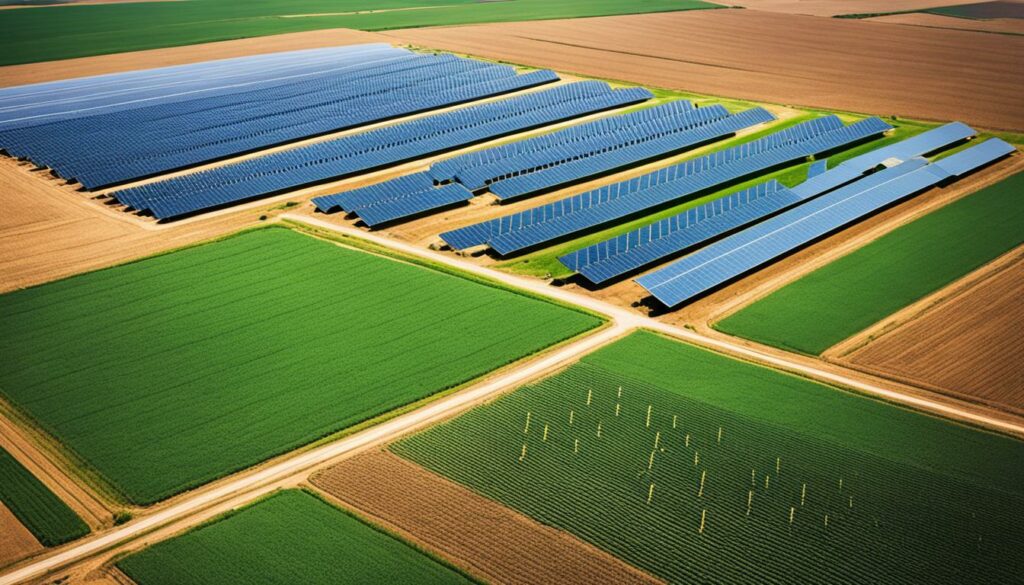
Following green rules can change how farms work, like at the United States Courthouse. It used less power and gas, getting a big award for its new green buildings. This shows that sticking to green rules can save resources and help the planet.
The Minneapolis Veterans Affairs Health Care System is another good example. It bought less paper and used less water for its plants. Their steps prove that following green rules can lead to big improvements like saving trees and water.
| Institution | Initiatives | Results |
|---|---|---|
| Argonne National Laboratory | Increased power management, enhanced composting | 49% increase in power managed computers, 226% increase in composting |
| Sam Rayburn Memorial Veterans Center | Rainwater harvesting, LED lighting, green practices education | Comprehensive environmental benefits |
| United States Courthouse | Electricity and natural gas use reduction | 30% reduction in electricity, 41% reduction in natural gas use, LEED Platinum certification |
| Minneapolis Veterans Affairs Health Care System | Double-sided printing, landscaping design changes | 31% decrease in paper purchase, 43% reduction in landscaping irrigation |
These examples show the benefits of following green rules. By using new farming techniques and following laws, farms and organisations achieved more sustainability. As farming changes, these stories will help shape future efforts and policies.
Looking at international farm equipment standards shows us different rules worldwide. Each country tries to increase farm work and protect the planet. The European Union (EU) leads with strict rules on farm work, focusing on clean air, energy, and less pesticide use.
In the United States, the EPA watches over the environment. They make sure farm work doesn’t harm the air, water, or use too much energy. This includes checking on greenhouse gases, the air we breathe, and the quality of water.
Bellow is a comparison on how each place’s rules affects what farmers can do:
| Region | Key Regulations | Impact on Equipment Standards |
|---|---|---|
| European Union | Emissions Directives, Energy Efficiency Standards, Pesticide Usage Regulations | Equipment must control emissions well and use less energy. |
| United States | EPA Regulations, Clean Water Act, Renewable Fuels Standard | Rules focus on reporting about greenhouse gases and managing water. |
| Australia | National Guidelines on Sustainable Agriculture, Biosecurity Regulations | Policies aim at safe farming and keeping out disease. |
| Brazil | Forest Code, Agrochemical Regulations | Measures help stop cutting trees and control chemicals used in farming. |
Comparing environmental farming policies teaches us how countries mix farming with caring for the earth. Some countries, such as the United States, let each state set many rules. Still, learning from other places helps everyone find better ways. The EU’s tough rules about pollution and saving energy are a big example.
Examining these different ways can guide us all to do better at farming without hurting the planet. By following these world views, we can update our ways to farm. It’s key to connect international farm equipment standards with our new green aims, now basic in farming.
The way we farm is changing because of new laws. These changes make sure we use farm machines safely. There’s a focus on having the right safety gear like rollover bars and seat belts. It’s important to check the machines well and keep them in good shape to stay safe. Tractors are often involved in bad accidents on farms, so these steps are really important. Doing safety checks and looking after your machines can save lives.
Also, the environment is a big deal in farming now. New rules help farms be both productive and green. They push for making sure machinery is safe and doesn’t harm the environment. Using new technologies can help prevent accidents with tractors. Keeping an eye on the condition of the fields is also key.
Looking ahead, farm rules are only going to get stricter. We have to keep up with these changes by using new technology and staying safe. Everyone in the farm industry needs to be focused on being green and safe. This way, farms can do well without hurting the environment or risking lives.
Farm equipment standards are key for both the environment and the economy in farming. They balance farming’s needs with the protection of our air, water, and the use of pesticides.These rules help the farming sector be eco-friendly without losing money.
In the past, many laws didn’t focus on farming, letting farms skip some environmental rules. But, as the need to protect our environment grew, so did the regulations on farming’s use of air, water, and pesticides.These regulations were designed to keep farms profitable while being better for the environment.
Recent rules target green issues like gas emissions and air quality. They urge the use of cleaner, more efficient tech in farming equipment.This has led to the development of greener farming machines.
The Environmental Protection Agency (EPA) and the U.S. Department of Agriculture (USDA) play big parts in making and overseeing these laws. They often work with local and state authorities to keep regulations in check.
New air rules make farms report on greenhouse gases. They ask for lower emissions from engines used in the farming machines.While better for health and the environment, these rules might increase costs for farmers.
The Clean Water Act demands certain permits for big animal farms and others. New water-saving tech is helping farmers meet these standards and be less of a strain on the environment.
The Renewable Fuels Standard aims to use more biofuels in farming to lower its carbon footprint. It’s pushing for more energy-saving tech in farm machines.This rule encourages the use of cleaner fuels in farming operations.
Regulations on pesticides make sure machines and tools used in farming are safe. They focus on keeping people and the environment healthy.These rules need constant review to ensure they’re up-to-date.
OSHA focuses on making farming safer. It covers areas like tractor safety, accident prevention, and safeguarding machinery.Its goal is to protect farm workers and their health.
The Right-to-Repair fight is for farmers to fix their own equipment freely. This is battling laws that keep repair tools from them.Its aim is to give farmers more control over maintaining their machines.
Certification ensures farm machinery is safe and eco-friendly. It affects how farmers work and how machines are made.Without these processes, the farming industry would struggle to meet high standards.
Sustainable farming suggests using equipment that’s kind to nature. It promotes practices that help the environment for the long term.By adopting these, the farming industry moves towards a more sustainable future.
The future of farm equipment looks to bring more tech, better efficiency, and less harm to the environment. Smart tech and data are foreseen to drive these changes.These trends will make farming more sustainable and environmentally friendly.
Farmers might find it hard to keep up with new standards due to costs and needed tech. It’s tough to balance progress with affordability.But, these challenges are essential as farming adapts to greener laws.
Case studies shine a light on new farming that’s both innovative and rule-abiding. They show what works in becoming more eco-friendly.They provide examples of success and where improvements can still be made.
Looking at how the world sets its farming standards can teach us a lot. We see different ways of tackling farming and its environmental impact.This comparison helps us understand the global effort to make farming better for nature.